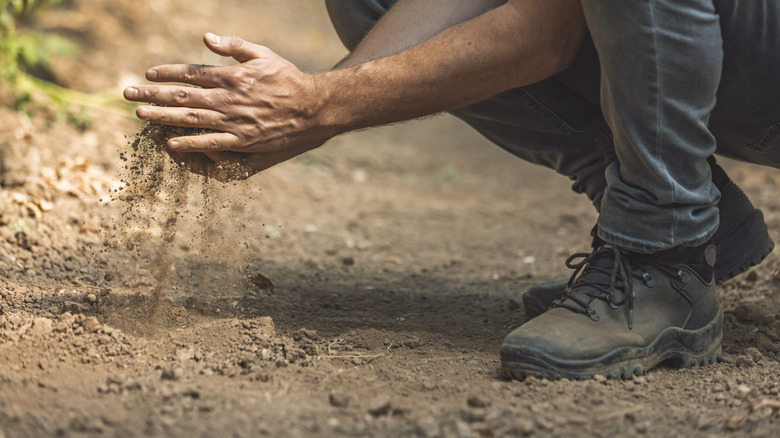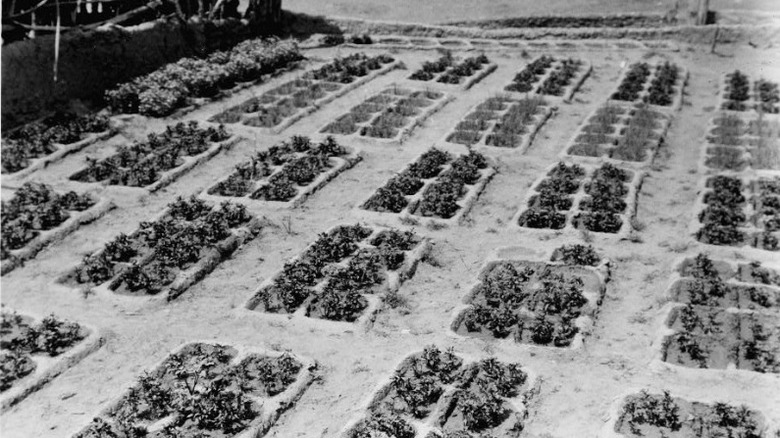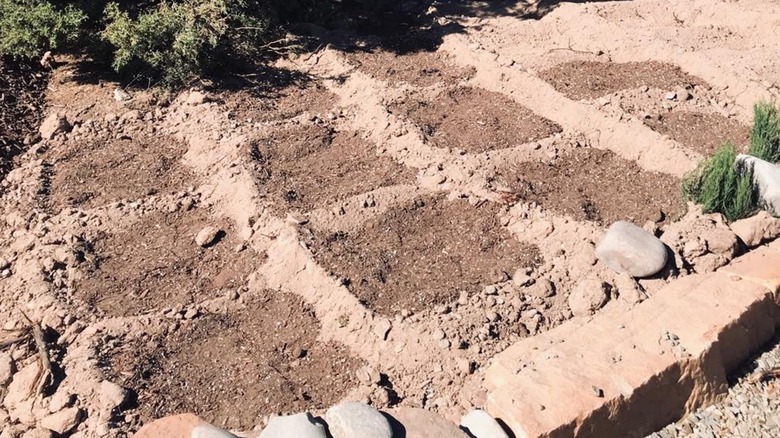What Is A Waffle Garden And How It Makes Growing In The Desert Easier
If you live in a dry climate, like a desert, attempting to garden and grow food can feel like being attacked from all angles. The scorching desert sun fries plants from above, while the shifty, dry soil saps away moisture from below and erodes in rushing rainwater. While it is challenging to live in, the desert can also be breathtakingly beautiful and is much more manageable if you understand ancient farming techniques like waffle gardening. No, we're not suggesting that waffles grow on trees in the desert, although that would be amazing. Waffle gardening is a planting technique that uses raised grids in the soil to prevent rainwater from immediately running away. This allows the water more time to seep into the soil, prevents soil erosion, and leads to happy, hydrated crops in even the harshest desert environments.
But this waffle gardening idea is no new trend. In fact, it's arguable that waffle gardens have existed for longer than waffles themselves. Learn more about the fascinating origins of waffle gardening, its importance in desert climates, and how you can create your own thriving waffle garden in your backyard.
The Zuni people's brilliant waffle gardens
The technique of waffle gardening was created over 4,000 years ago by the A:Shiwi, also known as the Zuni. The Zuni are an indigenous group of Pueblo people native to the Zuni River region of New Mexico. Despite living near the river, the Zuni people often struggled with farming in the hot, dry climate of the New Mexican desert, as the little rainfall would quickly escape the garden beds or evaporate into the hot desert air. That's why they developed a practice they called Latdekwi:we, or waffle gardening, to capture rainwater and retain as much moisture as possible. "They are the inverse of raised beds, and for an area where it is more arid, they're actually very efficient at conserving water," Jim Enote, a member of the Zuni tribe and CEO of the Colorado Plateau Foundation, told Civil Eats.
Usually, these gardens are made up of rectangular beds, each divided into roughly 1x1-foot squares. Waffle gardens could be short or long, but are usually only two to three cells wide to allow for easier access to garden plants. The interior cells were dug to be slightly shallower than the surrounding land, and were encased by mounds of clay constructed into walls. Creating little "pits" this way helped to direct water straight into the roots of garden plants. In addition to waffle gardens, the Zuni also used terracing to bring fertile soil and water runoff down from desert plateaus and into their gardens.
Creating waffle gardens for the future
As global temperatures continue to rise and droughts become more common, waffle gardening has become an important climate-conscious gardening skill for the future, especially for people living in hot desert environments like New Mexico. "Climate change will basically just make our extremes even more extreme," hydrologist Kirk Bemis told Civil Eats, "Most channels and rivers around here are ephemeral, or they just vary, and they really depend on storm events." Waffle gardens can be easily adapted to suit any family or size of land. However, they are best suited for hot and dry climates with well-draining soil, and may cause issues in gardens that are already too moist.
Luckily, building your own waffle garden is quite simple. Using a clay berm, soil, bricks, or stones, start by creating a border around the whole garden bed. Within that boundary, divide your garden into squares roughly 1 foot on each side. With a garden trowel, scoop dirt out from the center of your squares and pile it along the borders, packing it tightly into little berms about 2-3 inches tall. Continue until all of your squares are clearly defined. Adding a thin layer of gravel or topsoil into your square cells before planting can also help with water retention. When watering, focus the spray on the inside of the squares to avoid flattening your berms, and repair them as necessary. Wait for all of the water to soak into your "waffle" squares before watering again.


